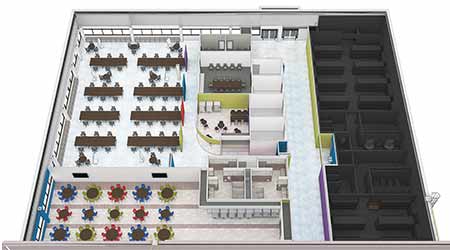 Having digital information immediately available for running accurate reports on various components of facilities is at the heart of BIM for facility management. Ghafari Associates
Having digital information immediately available for running accurate reports on various components of facilities is at the heart of BIM for facility management. Ghafari AssociatesWhy You Should Embrace BIM For Facility Management
First part of a two-part article examining the value of BIM as a cost-effective FM tool.
Building Information Modeling (BIM) is valuable for lifecycle facility management, and therefore should be on the radar of every large organization.
Because BIM provides instant, precise, user-friendly access to the location of building components that will require monitoring or replacement, BIM solutions will be the key to efficient facility management for the foreseeable future.
Cost-effective facility management is a byproduct of good information gathering and planning during the design and construction process.
This is why facility management leaders are vitally important participants in the programming, design, and construction phases of projects.
At the very first meeting with the design team, the importance of extracting building information from the model for facility management should be clearly articulated, defined, and demonstrated. This scope of work should be accounted for in the proposal.
The entire project team — owner, contractor, consultants, and facility management, as well as any critical stakeholders — needs to understand the effort required for inputting the data into the model and how it will be provided and extracted. That means robust project communication processes and tools. A solid BIM execution plan is critical for the success of project goals.
Here are insights to successfully support facility management with BIM when construction is complete.
Data developed during design and construction phases can be captured if the planning team looks ahead with an eye for specific programming requirements.
Begin with the lifecycle in mind. The team determines how to move data from the model to the facility management software solution in a user-friendly format — for example, formatting data in COBie (Construction Operations Building Information Exchange) to allow information to be exported from the models for the facility manager’s analytical purposes. Through this type of data exchange, the facility manager could be provided information needed for shipping and ordering parts on the installed piece of equipment with one click in the model instead of hunting through mounds of printed manuals. In addition, the maintenance team addressing equipment on site can view information quickly and conveniently through the utilization of cloud-based applications on tablets or smartphones in real time.
BIM also provides a visual and accurate virtual environment for building maintenance groups over traditional 2D processes. Consider this scenario: When maintenance is needed in a building to replace a variable air volume (VAV) box, it should not be necessary to remove all the tiles of a drop ceiling to find the actual location. Utilizing the virtual model, the maintenance team can identify the exact tiles to be removed, the clear space they have to operate, and whether there are any special safety considerations needing to be addressed. Being able to quickly understand the steps needed allows the task to happen with the least amount of site disturbance and wasted effort.
In addition, all the data about the VAV would be immediately and easily accessible. Items like warranty information, manufacturer maintenance requirements, service instructions, or a history of maintenance tasks already applied to this equipment could be provided by a scanned bar code on the equipment or through links in a virtual model.
Maximize perspectives. To achieve the best results from BIM, the entire project team needs to reinvent traditional thinking. By getting the owner involved at the beginning, the end users will start to see where they can benefit. Each user group offers a unique set of priorities. A facility manager would be particularly interested in the ability to quickly identify quantities and product information for installed building components. Utilizing BIM models can give automated reports on these building components. Doors are a good example: By toggling parametric data in the model, a facility manager can identify doors needing replacement or repairs, and what type of repairs are needed as well as associated costs. This data can then generate budgetary reports for total cost for maintenance. Another example — the BIM facility management process can be critical to produce the quantities of material and equipment for an insurance claim. The model can eliminate the need for an assessment crew to develop information from scratch.
A successfully implemented BIM process is not measured by the forms or documents produced, but a complete, comprehensive, and common understanding among stakeholders of the virtually constructed facility. If the goal of the project is to turn over a facility management model at the end of construction, the design team needs to know what the requirements are in advance. The technology is available, and if funds and timeframe have been appropriately planned, design teams can focus well beyond construction drawings. While BIM planning might increase costs to construction drawings, the savings for the life cycle of the project will substantially surpass the short-term investment.
Optimize data. The opportunity of data being stored in BIM is nearly limitless for facility management. This can include signage information, egress information, room data (including user names, room area, departments, furniture, finishes, and equipment in the room), life safety, solar studies, rentable space, leasing calculations, and countless others. BIMs can also link to other software, creating a single source for facility information, which can streamline the facility management process.
Related Topics:













